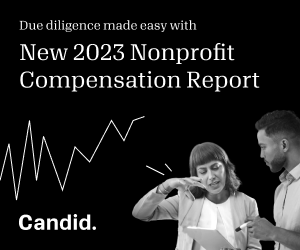Fostering solidarity and success in nonprofit leadership

As female presidents and CEOs of small nonprofits, Grantmakers in Health (GIH) and United States of Care, respectively, we understand the challenges and benefits of being women who lead, and the necessity of connecting with those who get it. And we were hell bent on setting up a support network to help us be better leaders. “Grabbing a coffee” with peers allows for networking, catching up, discussing the highs and lows of work, and brainstorming ways to work together, but we also know that “coffee conversations” can only provide so much support.
Women are underrepresented in leadership at for-profit and nonprofit companies alike. Only 21 percent of C-suite executives are women. It’s even worse for women of color, who represent only 13 percent of C-Suite roles. About 70 percent of nonprofit employees are women, yet we do not rise to leadership in the same proportion as men do. Even when we do lead nonprofits, we often don’t get the respect, support, and compensation men are afforded in the same positions, with women CEOs earning only 75 percent of what male CEOs do.
These challenges matter, and they continue to have major consequences. Many women are leaving the workforce or reducing their hours—29 percent considered doing so in 2022—partly due to experiencing higher levels of burnout. Long hours, shortened vacations, distracted parenting when an email comes in, and the feeling of wondering if we are doing a good job....It can feel isolating to navigate these leadership decisions, as we balance the impact of the organization and creating a culture where our teams thrive, both in and outside of work.
We should be doing everything we can to make the nonprofit leadership world more inclusive and equal, but there’s a long way to go. As a direct response to these challenges we (along with Katie Martin, the CEO of the Health Care Cost Initiative) started “Leading Ladies,” a monthly gathering of high-achieving women who lead healthcare nonprofits, often as first-time CEOs.
At a Washington, D.C., restaurant, food and drinks are plentiful and served family-style. There is no agenda and no posturing. The only “rules” are to show up authentically, support each other, and create a safe space to share. We talk about tactics and problem-solve. Often we laugh. Sometimes we vent. We always grow and learn from one another in our time together, leaving more hopeful, or at least more seen, than when we came in.
We all have remarkably similar experiences at work. Women face tough interpersonal moments on the job–whether with staff, boards, partners, donors, the media…the list goes on. We have both seen egregious differences in how men and women are treated in leadership roles, and experienced challenges such as being disregarded, undervalued, or not being taken seriously. This is even starker for leaders of color. Sometimes–often–expressing how we think and feel can seem like stepping around a landmine. How do we address current events with our staff? How do we handle the changing workplace after the pandemic? How do we support ourselves to thrive at work and outside of work?
In addition, leading small nonprofits can pose specific challenges. We brainstorm how to fundraise, acknowledging the challenges of brand recognition and communicating the organization’s unique value proposition within a crowded space. And as mission-driven organizations with mission-driven teams, we strategize on how to get the most work done, without becoming overwhelmed or stretching our resources—and how to help our teams balance the same. We have to balance wanting the work to be accomplished a certain way but not having the time to jump in and do it ourselves. Managing the shift from being a hands-on member of the team to becoming the leader of the entire organization— seems to be harder for women, given society’s expectation that we “do it all.”
Studies have shown that women are less likely to quit their jobs if they have strong support systems, and that’s what we endeavor to provide. We role-play situations we’re having trouble with. We forge new collaborations that would never have happened outside of this group. We also strategize on ways to uplift and support women within our organizations, fostering an environment that encourages more women to pursue C-suite positions.
Most importantly, through “Leading Ladies,” we’ve created a space where we can learn to give ourselves permission to vocalize challenges and seek support that will help us be better leaders in the long run. At every dinner, we realize that we, too, are going through or have gone through the situation that someone else is sheepishly raising, fearing they are the only one struggling with an issue. For instance, one of our members was doing three jobs and was extremely burnt out. Our group was able to give her the needed perspective that she had too many responsibilities. She worked with her board to create two more senior-level jobs: just to cover the work she was doing on a regular basis.
Our efforts with the group serve as a testament to the immense power that women can wield when they unite in support of one another. By creating safe environments for networking, mentorship, and collaboration, female solidarity plays a crucial role in overcoming both professional and personal challenges faced by women leaders in the nonprofit sector. This collaborative approach not only helps individual leaders succeed but contributes to the overall growth and impact of the organizations we lead. We encourage other women leaders to join groups like ours or establish their own, as these connections can be crucial for personal and professional growth and for making the playing field more equitable.
Cara James is president and CEO of Grantmakers in Health (GIH), and Natalie Davis is president and CEO of United States of Care.








Beyond programs: The importance of funding capacity-building and operating expenses